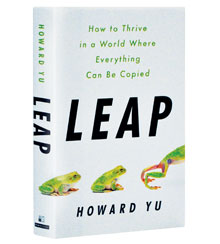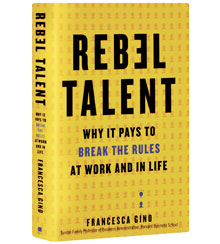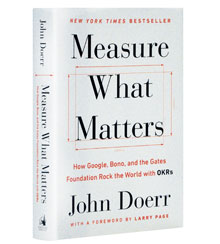Best Business Books 2018: Strategy
Making the Leap. See also Top Shelf Picks: Best Business Books 2018.
Howard Yu
Leap: How to Thrive in a World Where Everything Can Be Copied (PublicAffairs, 2018)
Francesca Gino
Rebel Talent: Why It Pays to Break the Rules at Work and in Life (Dey St., 2018)
*A TOP SHELF PICK
John Doerr
Measure What Matters: How Google, Bono, and the Gates Foundation Rock the World with OKRs (Portfolio/Penguin, 2018)
How can you innovate to avoid irrelevance? How can you nurture your best people, especially the rebels? And how can you set goals and objectives effectively to make sure your company succeeds? These are key questions for anybody charged with developing strategy for a large organization. And they are answered with clarity and verve in this year’s best business books on strategy. In Leap: How to Thrive in a World Where Everything Can Be Copied, management professor Howard Yu uses history to lay out a path for resisting disruption. In Rebel Talent: Why It Pays to Break the Rules at Work and in Life, Francesca Gino, a behavioral scientist and Harvard professor, upends the conventional wisdom on dealing with people who have difficulty adhering to norms. And in Measure What Matters: How Google, Bono, and the Gates Foundation Rock the World with OKRs, John Doerr, a legendary venture capitalist, applies an engineer’s discipline to the thorny question of how best to use metrics.
Logical Leap
When Howard Yu was studying for his Ph.D. at Harvard, Clayton Christensen was one of his supervisors. And to a large degree, Leap builds on Christensen’s work on disruptive innovation. “Is the displacement of early pioneering companies an inescapable fate in the modern economy?” Yu asks. The answer is yes — but not for those who can leap.
The competitive advantage that accrues from scale, or great brands, or patents, is evanescent. But looking back through history, Yu has found that companies that survived dramatic shifts were able to leap from one knowledge system or foundational discipline to another. The book, which straddles business history and strategy, hangs on a simple but brilliant analytical frame: the knowledge funnel. As companies mature and scale up, they move (or leap) within the funnel from craftsmanship to mass production to automation. Think of Procter & Gamble, or Ford, or Yamaha as they first made soap, cars, and pianos by hand, then made them on an assembly line, and then automated production.
But in order to survive dramatic shifts, successful companies also have leapt sideways into new areas of foundational knowledge. For Swiss pharmaceutical companies that trace their lineage to the 19th century, the leap has been from organic chemistry to microbiology to bioinformatics and genomics. For P&G, the leap was from the discipline of mechanical engineering into the disciplines of consumer psychology (understanding marketing and advertising) and chemistry.
Yu identifies five clear and pragmatic principles at the center of the leap philosophy: (1) understand your firm’s foundational knowledge and its trajectory; (2) acquire and cultivate new knowledge disciplines; (3) leverage seismic shifts; (4) experiment to gain evidence; and (5) dive deep into execution.
It may sound simple. But making leaps successfully isn’t easy — they’re costly, from both a financial perspective and an emotional one. CEOs have to be willing to stake their personal and professional future on what may seem to be long-shot bets. Companies that leap have to continually reassess their foundational cores and seek to cannibalize their own success.
In the second half of the book, Yu looks at 21st-century companies such as WeChat, and highlights the knowledge funnel they must follow: from the wisdom of the managerial few (craftsmanship), to reliance on the wisdom of the crowd (outside developers) to mass-produce apps; the leveraging of machine intelligence and artificial intelligence (automation). And he describes how John Deere, which in the 19th-century made the difficult leap from horse-powered plows to steam-powered tractors, is still leaping. The company is leveraging ubiquitous connectivity and artificial intelligence to build largely autonomous tractors that can fend off low-cost competition. “Climbing into the driver’s cabin feels a little like stepping into a spaceship,” he notes.
Yu, who teaches at the International Institute for Management Development Business School in Switzerland, is a fluent and imaginative storyteller. He has a knack for the pithy phrase: “Strategy…is never about achieving perfection; it’s about shortening one’s odds, at best” and “Core competencies turned into core rigidities.” The substantive, detailed accounts he offers really hit home. That may be in part because the products he describes — pianos, cotton, soap — play an active role in family life. But it’s also because Yu makes an eloquent plea for the primacy of human judgment and influence. AI is “an augmentation technology,” he notes. The three big points of leverage he identifies for the future are ubiquitous connectivity, the rise of intelligent machines, and a stronger emphasis on human creativity.
Indeed, in an age of big data, developing groundbreaking insights requires humans to empathize with the needs, frustrations, and experiences of customers and citizens. One of the most compelling case studies he offers is of the New York homeless-services organization Common Ground. The leaders, showing deep empathy, immersed themselves in the life circumstances of the population that was once called “service-resistant” and moved quickly to potential solutions that could ultimately be scaled up.
It’s hard to cover a lot of ground in a short book. And if there were to be a sequel to Leap — Leapt? — it would be useful to hear more about how CEOs can create teams capable of leaping, the obstacles companies face, and what precisely goes through the minds of leaders when they are about to jump.
Rebel Yell
Not many strategy books open with the author describing a stint working in the kitchen of the restaurant run by the famous Italian chef Massimo Bottura. But Francesca Gino, perhaps fittingly given the title of her book, doesn’t follow the usual script. The youngest person to get full tenure at Harvard Business School, where she is Tandon Family Professor of Business Administration, Gino is a behavioral scientist by training. In some of her early research on why people cheat on taxes or exams, she began to notice (1) that people often are disengaged at work; and (2) that rule breaking is associated with innovation.
The central premise of Rebel Talent is that rebels — people who consciously don’t follow the rules, or have great difficulty doing so — are good for business. Why? “Rebels don’t believe they have limits on what they can achieve,” she notes. They challenge the status quo. She uses a memorable phrase that encapsulates the three acts in which rebels engage: “Break, transform, create.” Napoleon Bonaparte, a notable historic rebel, dispensed with centuries of clotted military thinking to devise his own highly successful tactics. In fact, studies show that people who violate norms — by, say, wearing hoodies to business meetings, or wearing colorful sneakers to teach a graduate school seminar — are often seen as more powerful. Rather than punishing or trying to confine rebels, leaders should strive to create the conditions under which rebels can flourish.
Rather than punishing or trying to confine rebels, leaders should strive to create the conditions under which rebels can flourish.
In an age of standardization, that may seem a difficult task. But Gino breaks it down by describing the five elements of rebel talent: novelty, curiosity, perspective, diversity, and authenticity. Rebel Talent is very much in the mold of behavioral economics classics, using academic studies, examples, and data to prove provocative points. Gino cites studies tying novelty to engagement at work. She highlights the example of Pal’s Sudden Service — a burger chain in Tennessee and Virginia known for its remarkably fast service and low turnover, where employees are continually challenged to do new tasks.
The book, the most engaging of the three under review, comes into its own in the latter stages, in which Gino sets out eight powerful principles of rebel leadership, three of which I found most distinctive: encourage constructive dissent and open conversations; learn everything and forget everything by going back to fundamentals; and foster happy accidents by designing workplaces that enable collaboration. She emphasizes that rebels make time to think and wonder, even when they’re extremely busy, if they’re fully engaged in their work. They rebel against time itself, which is both a wonderful turn of phrase and a premise.
Gino’s favorite rebel is clearly Bottura, the chef in Italy who breaks many of the rules adopted in the hierarchical restaurant business. Bottura unloads the food truck himself, plays soccer with the staff, and frees employees to work on a range of tasks rather than pigeonholing them.
Rebel Talent is informed by a rich seam of research and an intense passion for the subject, and for seeking knowledge and perspective. “When we open ourselves to curiosity, we are more apt to reframe situations in a positive way,” Gino writes. She challenges conventional wisdom in the workplace by setting out the benefits of giving employees space. The Italian typewriter company Olivetti, long before it was au courant, built playgrounds for workers’ children, gave employees long lunch hours, and encouraged employees to expand their intellectual horizons — all as a way of building up curiosity as a corporate discipline.
The author is clearly on a mission, and in a bit of a hurry. (She finished her Ph.D. in three years.) Breezily written and easily digestible, the book is packed to the brim with examples. Its references run to 39 pages. At one stage we move from Ford to Gino’s family room and then to the BBC in the space of less than two pages. But Rebel Talent also stands out for its passion, personality, and insight. Gino peppers the text with personal and engaging stories of her family, her marriage, and her Harvard classroom. And she clearly believes there is more work to be done. She has created an online learning platform for others to share more rebel stories and hosts a test that enables users to self-diagnose their rebel type. Her work ultimately prompts the question of why more leaders don’t make it easier for rebels to flourish, and, if the argument is pushed further, why workplace cultures are not so inclusive that the word rebel becomes unneeded.
Measure for Measure
In Measure What Matters, John Doerr, a pioneering venture capitalist, describes how a simple strategy playbook used to great effect by highly successful engineering companies can be deployed by anybody. Part memoir, part business book, and part guide for perplexed managers, Measure What Matters is a clear and very well-designed book (as befits its topic).
For Doerr, it all comes down to the mantra he learned at the feet of his mentor and hero, longtime Intel CEO Andrew Grove: “Ideas are easy. Execution is everything.” To Doerr, execution relies on using OKRs (objectives and key results) effectively. OKRs, he writes, are “a collaborative goal-setting protocol for companies, teams, and individuals.” The objective is what you want to achieve, and the key results help you benchmark and monitor how you get there. Deploying this strategy requires four OKR superpowers: focus, alignment, tracking, and stretching. On a more inspiring note, OKRs are what “empower people to achieve the seemingly impossible together.”
Doerr, the self-described “Johnny Appleseed of OKRs,” looks back over his incredibly successful career, telling stories of how and where and why he used — or encouraged the use of — OKRs. Google, in which Doerr was an early investor, figures prominently. But so, too, do the Gates Foundation, Adobe, Intuit, and Bono’s One Campaign.
To a large degree, this book is aimed at startups desperately needing some structure and focus as they look to survive, and then scale. But everything he says is relevant to organizations of all sizes. And there’s cracking advice for leaders and managers throughout the book, and memorable quotes: “OKRs are adaptable by nature. They’re meant to be guardrails, not chains or blinders.” Doerr reminds us to aim high when we set objectives. As Google cofounder Larry Page put it: “If you set a crazy, ambitious goal and you miss it, you’ll still achieve something remarkable.” Stretch goals can galvanize an organization to outstanding performance.
The OKR system is fascinating, as is the book. The idea may hardly be revelatory. But the focus on execution is. Managing in this way requires intense executive focus, far greater levels of transparency and accountability than are customary, and dialogue and teaming across often disparate organizations. While reading, I played out my own career moments, and those of some of the organizations I’ve been fortunate to work with, and realized that had we adhered to OKRs with more discipline we’d have been better off. I imagine many executives will read the book, and, at first blush, think that they apply this system already. If they’re honest, they’ll then read through the examples of startups, stories told through the eyes of the founders who’ve used the system, and realize they haven’t. For example, Doerr says that executives should ask much simpler questions of themselves and their team. Rather than project five years into the future, they should ask what the most important problems and issues are for the next three (or six, or 12) months.
Measure What Matters is at its best when it gives us a peek behind the scenes of the early days of some of Silicon Valley’s success stories, and the interventions Doerr made. He encouraged then Google CEO Eric Schmidt to work with a coach, for example. The case studies are real, candid, direct, and credible. And instead of simply rehashing history, Doerr looks ahead. The second half of the book describes how OKRs can be deployed in the new world of work — how processes applied to software and machines can best be applied to humans. Here, he has another powerful three-letter abbreviation: CFR. That stands for “conversations, feedback, and recognition.” The way to give “OKRs their human voice,” he argues, is to dispense with annual reviews and instead continually connect and check in with colleagues and employees to make sure everyone is on the same page. Doing so won’t just improve morale — it will encourage the alignment, autonomy, and engagement that are necessary if companies are to pursue and achieve their OKRs. High-performing businesses, Doerr correctly notes, require continuous performance management.
Though I would have liked to learn more about how the executives he worked with convinced their people to adopt the OKR system, Measure What Matters leaves readers with vivid, immediate, practical guidance on how to execute their strategy with the confidence that they’re following in the footsteps of some of the world’s most successful entrepreneurs. It certainly challenges conventional wisdom and practice. Perhaps Doerr, a member in good standing of the Silicon Valley establishment, is a rebel, after all. And his system is certainly a critical ingredient for companies looking to leap from one schema to another.
Author profile:
- David Lancefield is a strategist and coach who has advised more than 35 CEOs and has led 15 digital transformations. He is a contributing editor of strategy+business, and he also hosts the interview series Lancefield on the Line and publishes the email newsletter Flashes+Sparks. Lancefield was a senior partner with Strategy&, PwC’s strategy consulting business.








